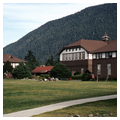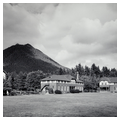The formally planned campus of Sheldon Jackson College is one of the few assemblages of buildings in Alaska axially arranged around an open space. The formality of the campus reflects the training of the architects, the New York firm of Ludlow and Peabody. Charles F. Peabody studied at the Ecole des Beaux-Arts while his partner, William Orr Ludlow, had worked in the office of Carrère and Hastings. Ludlow and Peabody formed a partnership in 1909 and the next year designed this campus. Five major buildings,
Founded as the Sitka Mission in 1878, the school is the oldest educational institution in the state. The boarding school, providing an eighth-grade education, was established by John G. Brady to train Native boys in American vocations and ways. Brady was a Presbyterian missionary who later became governor of Alaska. But it was the force and energy of the untiring Sheldon Jackson, another Presbyterian missionary, who saw to the school's survival. When its building burned in 1882, Jackson undertook a fund-raising campaign, cleared a new site, used lumber from an abandoned cannery 6 miles away, and constructed a 50-foot-by-100-foot, three-story building on this site. In 1884 the Presbyterian girls' school was transferred to Sitka from Wrangell, and construction continued through the 1880s and 1890s.
In 1910–1911, most of the then-existing buildings were demolished and the present campus constructed. At the same time, the school changed its name from the Sitka Industrial and Training School to the Sheldon Jackson School. In 1917, Sheldon Jackson High School was established, in 1944 the junior college opened and non-Natives were admitted, and in 1976 it offered its first four-year program.
Additional buildings have since been added in a way that respects the 1910–1911 Ludlow and Peabody design. One pre-existing building, the Sheldon Jackson Museum, stands off to the southeast; nearby a library designed by Waldron and Dietz, architects from Seattle, was constructed in 1974. Other new buildings are generally located behind the original five. The harmony of the original buildings and the compatibility of the later ones combine with an unusual respect for the landscape to make this an extremely attractive campus.




